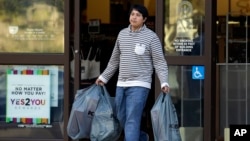U.S. economic growth was slower in the last three months of 2015, but did not slow as sharply as previous estimates had predicted.
The U.S. Gross Domestic Product, or GDP, expanded at a 1.4 percent annual rate in the fourth quarter, instead of the previous estimate of 1.0 percent, according to the Commerce Department's third and final estimate released Friday.
Consumer spending grew 2.4 percent instead of the previous estimate of 2 percent. The stronger consumer spending helps ease fears of a U.S. recession, which along with plunging oil prices and the slowdown in China triggered volatility and stock market sell-offs earlier this year.
Consumer spending accounts for more than two-thirds of U.S. economic activity. Housing also added to U.S. growth, in part because of low mortgage rates.
Gus Faucher, chief economist at PNC Financial Services, is forecasting GDP growth of 2.1 percent for all of 2016 with job growth of around 170,000 each month. That's above the pace needed to keep up with normal population growth.
Economist Chris Ripkey at MUFG Union Bank in New York says the consumer is back in the driver’s seat.
"There is no sign of a recession in these data," said Ripkey, who believes the latest GDP estimate means the U.S. Federal Reserve's policy of gradual interest rate normalization will continue.






